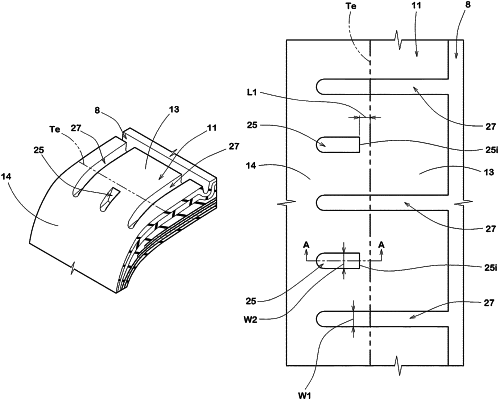| CPC B60C 11/005 (2013.01) [B60C 11/0008 (2013.01); B60C 11/24 (2013.01); B60C 2011/0025 (2013.01); B60C 2011/0367 (2013.01); B60C 2011/0372 (2013.01)] | 14 Claims |

|
1. A tire comprising:
a tread portion having a pair of tread edges, a tread surface extending between the tread edges and a pair of buttress surfaces extending axially outwardly from the respective tread edges, the tread portion comprising a tread rubber including a radially outermost first rubber layer forming the tread surface and made of a first cap rubber compound, and a second rubber layer disposed on the radially inside of the first rubber layer and made of a second cap rubber compound,
wherein
the buttress surfaces have inclinations such that the tread edges shift axially outwards as the tread rubber is worn off,
a loss tangent δ2 of the second cap rubber compound is larger than a loss tangent δ1 of the first cap rubber compound,
one of, or alternatively, each of the buttress surfaces is provided with outer lateral grooves extending in a tire axial direction, and
the outer lateral grooves are arranged axially outside the tread edge from which the buttress surface extends axially outwards so that, when the tread edge shifts axially outwards due to wear of the tread rubber, the outer lateral grooves are at least partially positioned axially inside the tread edge, and
wherein
in a new state of the tire in which the tread portion is not worn,
an axially inner end of each of the outer lateral grooves is positioned at an axial distance L1 of 2.0 to 10.0 mm axially outward from the tread edge; and
each of the outer lateral grooves has a maximum depth at a middle position in the groove length direction, and the groove depth decreases continuously from the middle position toward the axially inner end and axially outer end of the outer lateral groove,
the outer lateral grooves each have: a first circumferential edge on one side in the tire circumferential direction; a second circumferential edge on the other side in the tire circumferential direction; an axially outer edge connecting between an axially outer end of the first circumferential edge and an axially outer end of the second circumferential edge; and an axially inner edge connecting between an axially inner end of the first circumferential edge and an axially inner end of the second circumferential edge, and
in a plan view of the tread portion, the first circumferential edge and the second circumferential edge linearly extend in parallel with each other, and the axially outer edge extends in an arc shape.
|